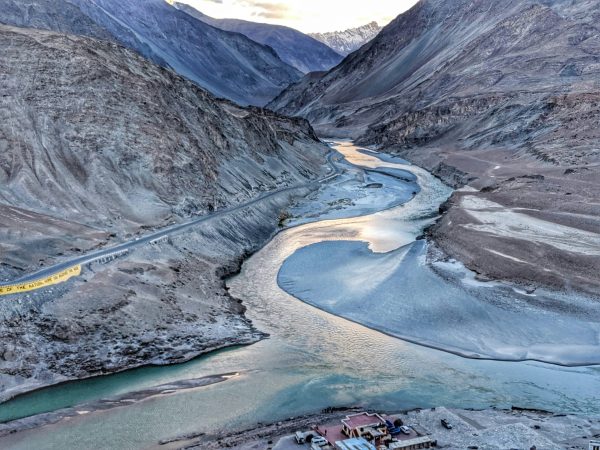Our brains are not built to deal with the problem of climate change. No amount of worrying about the planet can override the brain’s evolutionary inclinations to keep destroying it. How can we fix this gap between how much we care and our ability to express that care through our daily actions? What would it take to get our brains aligned with the work the planet needs us to do? Can we rewire our brains to meet the climate crisis?
Cognitive psychologists, social psychologists, and neuroscientists have studied the role of the brain, thoughts, and emotions in determining environmental behavior. They show how brains are machines that filter out some information in favor of more salient information, because otherwise we’d be bogged down in an infinite churl of decision-making, demands on our attention, and evaluating risk-benefits moment to moment. Over time, the brain’s attempt to simplify the complex world through “biases,” nervous system responses, and reward circuitry evolved to keep us alive.
But some of this wiring is at odds with what we need to do to address global warming.
One example is our perception of risk. Our nervous systems detect threats when our brains perceive them to rank high on likelihood, magnitude, immediacy, intentionality, and agency (meaning that the threat feels greater if it has a face). Even if you are already feeling its effects, climate change ticks none of these boxes. It isn’t a scary intruder, it is often subtle or slow-moving in its assault, and its impacts are amorphous. It simply fails to trigger the threat response systems our nervous systems need to mobilize self-preservation. Without these criteria for threats, or positive alternatives to reach for instead, even a bad case of climate anxiety is not enough to move people to change their behavior.
Our individual actions never happen in a vacuum, and systems only change because individuals collectively demand that they do.
Here are a few more ways our brains are not wired for warming. They
- prioritize the wellbeing of our present self over our future self (present bias);
- focus on threats that are in immediately in front of us, not in the distance or future (hyperbolic discounting);
- prefer to stay the course rather than make changes (the sunk-cost fallacy or status quo bias);
- make decisions based more on what other people around us are doing than for any rational reason (social comparison);
- imagine a future that resembles what we can most easily recall in our memories (often from news, social media, or popular culture) rather than what we might desire, much less all the possibilities of what could happen instead (availability bias);
- are willing to change behavior only if the reward is perceived to be higher than the sacrifice (reward bias);
- and worst of all, our brains do not like to expend effort unless they know the effort will make a difference (pseudoinefficacy).

What do all of these biases have to do with climate change? For one, climate change is a complex phenomenon, not an immediate threat with obvious malintent and a face; it is what risk theorists would call “non-agential.” Additionally, we cannot viscerally perceive it, like pollution in the air or a bear attacking us, and when we can, it’s not only “too late” to stop, it is also not recognizably “climate change”. Rather, we experience an extreme weather event, a hotter summer, a delay in a beloved species’ migration, rising sea levels, melting permafrost, or the disappearance of subsistence options. In such cases, it can be difficult to get our sympathetic nervous systems to respond. And even if they did, the work required to prevent these threats would need to have been done a long time ago. This delay between our nervous system’s awareness of a threat and any action we might take to prevent it is the tragic result of not being wired for warming.
What’s more, it isn’t entirely clear what the cause of climate change is, as experts are often portrayed as disagreeing about the most urgent solutions. To make matters worse, many people around us seem to be doing nothing about it, so we, too, carry on. After all, when in doubt, the status quo is easier for our brains to accept. Then, instead of trusting those experts, we rely on our social biases (including confirmation bias) to shape our behavior, and since the rewards of changing business-as-usual do not appear to outweigh the costs (status quo bias), it is cognitively easier to kick the can down the road to future generations, to magical politicians, or to nature itself. These forms of disavowal and denial are cognitive solutions to the challenges of grasping the threats of climate change.
Many of us feel that our actions can hardly make a difference against such a massive problem anyway, so most of us just give up. That, combined with the seductive message that individual change is insignificant compared to system-level change makes us feel that nothing we do could possibly matter (learned helplessness).
We are all constrained by systems that attenuate our agency and shape our power, and these systems are designed to take power and agency away from some communities while affording them to others. As extent to which we are able to reclaim our agency where we have surrendered it with “learned helplessness,” we need to be doing so in ways that rebuild more equitable systems. There are real, material limits to the ability of some people to simply “wake up” to their own power, to be sure, but the point is not that our helplessness is all in our head. The point is that the very systems that benefit from us believing ourselves to be helpless also benefit from ensuring that some people have a lot of power while others do not.
No wonder colonizing Mars and geoengineering cooler atmospheres seem like such novel options; when you compare the risk-reward incentives, fighting climate change in all the ways experts already prescribe feels just. Too. Hard. This is your brain on climate change.
But maybe I’ve already lost you because you believe that targeting the individual brain at the scale of the individual is inadequate from the outset. It has been trendy in climate spaces to disavow the role of the individual in favor of emphasizing the much more urgent necessity of system change. But this impulse to disavow individual change because it’s easier to blame systems is a symptom of status quo bias. This binary view of how change happens is false; systems are made up of individuals (admittedly with varying levels of power to change those systems), and at least in the U.S., an average individual has an oversized impact on the climate than anybody else in the world. Plus, our individual actions never happen in a vacuum, and systems only change because individuals collectively demand that they do. Theories of change that reject the role of individual efforts ignore all the research that shows how impactful change at the personal scale can be.
As the Buddhist climate activist Paul Hawken writes, “the most complex, radical climate technology on earth is the human heart and mind, not a solar panel.”
Put another way, if you’re an average American reading this, you have incredible power to mitigate climate change.
So how can you leverage your brain to better address climate change? As the Buddhist climate activist Paul Hawken writes, “the most complex, radical climate technology on earth is the human heart and mind, not a solar panel.” What would it take to better enlist this radical technology?
-
Increase Awareness
Mindfulness practices are uniquely suited to this work. First, we need to become aware of how these subconscious biases condition us to feel helpless, apathetic, or even nihilistic. Sure, climate change is a problem, but why let your brain make matters worse? You can learn to identify how these biases show up in you. For example, you can begin to notice when your mind tells you the story of having no power, or how you move toward present pleasure and away from future forecasts, and how you perceive risk. Mindfulness also permits us to notice our climate anxiety triggers and get comfortable with discomfort– essential tools for facing reality.

-
Build new mental habits
The second step is to reject the underlying bias of most Western cultures, which is that the brain and the self are fixed and unchangeable. On the contrary, neuroscientists have shown that brains are more like plastic, and can, with regular practice, be changed. Again, mindfulness is a research-proven tool for changing one’s mind. We do not have to accept these biases as “how things are.”
-
Personalize reward-based interventions
The negative frame of climate change is a stick, and sticks don’t motivate change. Change can be immensely pleasurable – think of all you could gain! This neuroscientific insight is at the heart of the radical concept of “pleasure activism,” for example. So the third step is to use the enormous research on behavior change to build reward-based interventions in your life and in others to ensure that the rewards of behavior-change outweigh the perceived costs.
Climate action is often framed as a sacrifice, yet deprivation rarely inspires significant behavior change. By contrast, nudge theory and choice architecture, strategies from marketing and addiction research, for example, work with the brain’s reward circuitry. Using mindfulness, examine how the market conditions pleasure for you, and begin to explore the abundance (as opposed to deprivation) that could come from ethical action. Buddhist thought can also help us explore skillful livelihood and skillful action, which are reasons to do the right thing regardless of the outcomes.
So the question becomes, How can you use your spiritual practice to make right climate action pleasurable?
-
Live in a story that’s better for the planet
Yet a fourth step to cracking the climate bias code is to reframe the story we are living in. Our biases tell us the story that we have no power, that it’s too late, that we don’t have to worry about this yet, that the risk isn’t that big, that change is unpleasant, that we are alone in our feelings, that experts have this all under control, and so forth.
But for every one of these biases, there is an alternative story that is just as true, if not more true. Joanna Macy’s Work that Reconnects teaches us that the planet needs us to live in a story of the Great Turning. Following Macy, we can attend to how we allow ourselves to live in, believe, perpetuate, and manifest the story of the Great Unraveling. We can devote our attention to the ways in which we have much more power than we’re told by the powers that be.
And there are innumerable stories about solutions that don’t penetrate the media’s negativity bias. Simply living in a story of what’s possible, and knowing you are surrounded by people building a better world, would override many of these biases.
-
Attune yourself to the more-than-human world
Speaking of attention, another reason climate change fails to capture our risk perception is because most of us have not learned how to perceive what is happening in the ecological world. Yet climate effects are occurring now, so we can learn to perceive it with our senses, learn to listen to and read the landscape’s suffering, and begin to see climate change all around us, if we don’t already. This strengthens the neural pathway associations between what we perceive and the threat we want to avoid.
Acting in concert with others stokes our reward systems even more than the comfort of knowing that our actions are effective.
- Tap the power of social contagion
Perhaps the biggest step you can take as an individual is, ironically, to challenge the view that you are an isolated individual in the first place, because the view that you are an individual is getting in the way of your best climate action.
If you get all your news from mainstream and social media, you might get the impression that there are a lot more climate deniers out there than there really are. On the contrary, the majority of people care a lot about climate change, so you are not alone.
Acting in concert with others stokes our reward systems even more than the comfort of knowing that our actions are effective.
The false perception that you are alone in your concern is at the root of pseudoinefficacy. And, research shows that you are less likely to act if you feel alone in your actions, so your pseudoinefficacy becomes a feedback loop of inaction.
In other words, at the root of both our biases and our socio-ecological crises is the myth of the individual. To counterbalance this bias, we need to deeply perceive all the good company we’re in (both human and more than-human), learn how to perceive climate change in the socio-ecological webs in which we are embedded (thereby making climate change more personal and intimate), and deploy the power of the collective in creating system change. All of these practices require a level of critical thinking against the grain– mental habits that mindfulness can condition.
These are critical interventions in your brain’s wiring that you can do, right now, for the sake of your mental health and for the sake of the planet. If our brains aren’t wired for climate change, let’s rewire them.







